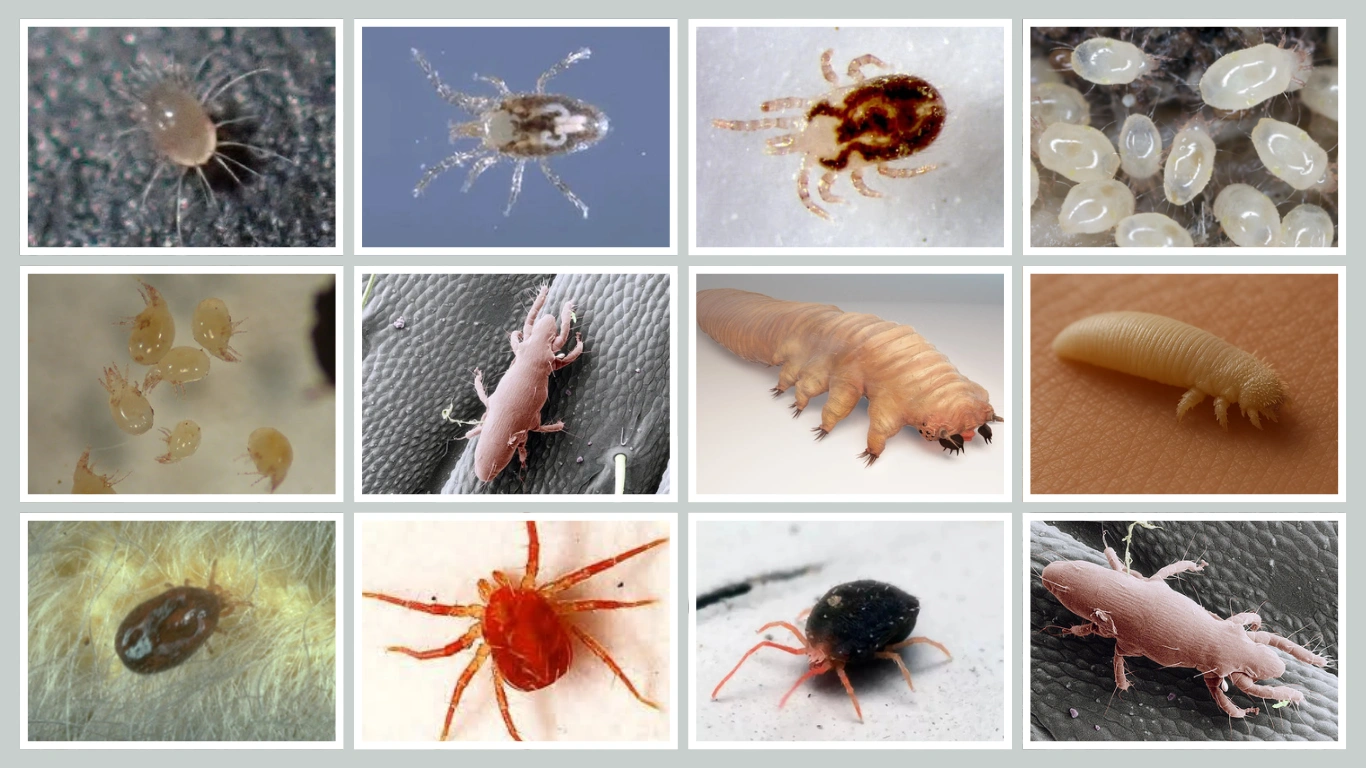Mites are tiny arachnids that can live unnoticed in many parts of your home—bedding, furniture, stored food, even on your skin. While most are harmless, some can cause allergic reactions, skin irritation, or food contamination. In this guide, you’ll discover 15 common types of mites found indoors, how to identify them, where they hide, and what risks they may pose to humans and pets.
1. House Dust Mite (Dermatophagoides pteronyssinus)
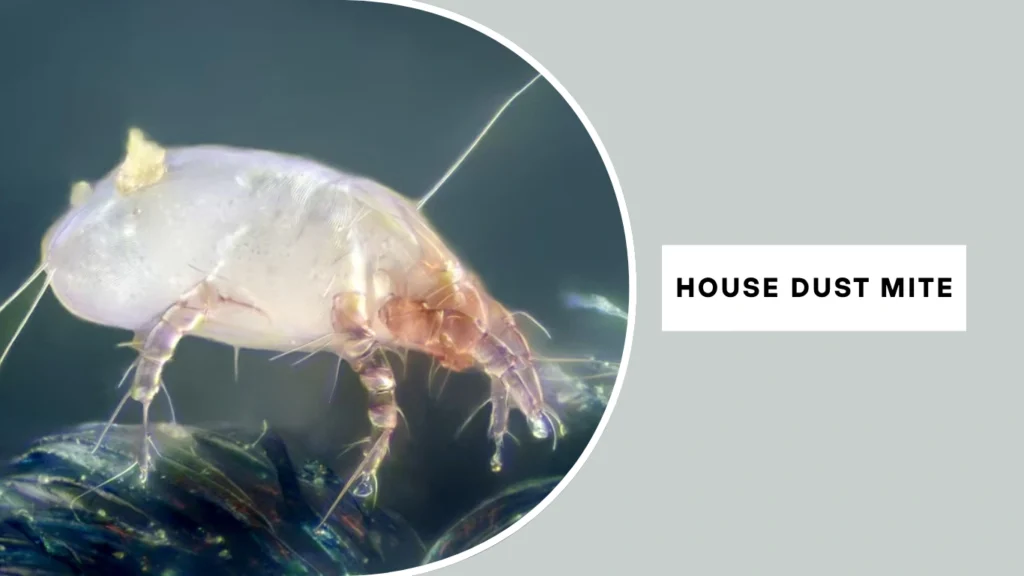
House dust mites are microscopic arachnids commonly found in household dust. These mites thrive in warm, humid environments and feed on dead human skin cells. They do not bite or sting, but their waste and body fragments can trigger allergic reactions in sensitive individuals. These mites are invisible to the naked eye and are most concentrated in bedding, upholstered furniture, and carpets.
Identification
- Size: 0.2–0.3 mm long
- Shape: Oval, with eight legs
- Color: Creamy white or pale gray
- Visibility: Not visible without a microscope
- Movement: Slow-moving and non-aggressive
Common Hiding Places
House dust mites are most often found in mattresses, pillows, beddings, carpets, curtains, and fabric-covered furniture. They prefer places with frequent human skin cell shedding and higher humidity.
Allergic Reactions Caused
Exposure to dust mite allergens can cause sneezing, runny or stuffy nose, watery eyes, coughing, asthma flare-ups, and eczema. Symptoms are often worse in the morning after waking up due to their presence in bedding.
Control and Prevention
Regular washing of bedding in hot water, using allergen-proof covers, maintaining indoor humidity below 50%, vacuuming with HEPA filters, and removing dust-collecting fabrics can help reduce their numbers.
2. American Dust Mite (Dermatophagoides farinae)

The American dust mite is another common species found in household environments. Like its European counterpart, it feeds on dead skin flakes and thrives in warm, humid areas. It is a leading cause of indoor allergies and asthma, especially in homes with poor ventilation and excessive dust.
Identification
- Size: About 0.3 mm
- Shape: Oval, eight-legged arachnid
- Color: Off-white with a slight brownish tint
- Microscopic: Cannot be seen with the naked eye
- Habitat: Found in dust, fabrics, and bedding
Preferred Conditions
This mite flourishes in areas with humidity levels above 50% and temperatures between 20–25°C (68–77°F). Bedding, carpets, and curtains are their favorite habitats.
Health Impact
They are responsible for causing allergic rhinitis, sinus congestion, itchy eyes, and triggering asthma attacks. Sensitive individuals may also develop skin irritations.
Reduction Methods
Use dehumidifiers, wash bedding weekly in hot water, install allergen-proof mattress covers, and minimize upholstered furniture to reduce mite populations.
3. Clover Mite (Bryobia praetiosa)

Clover mites are tiny red or reddish-brown arachnids often found crawling around windowsills, walls, and furniture in homes. Unlike dust mites, they do not feed on dead skin but on plant material. They may enter homes in large numbers during spring or fall.
Identification
- Size: 0.75 mm (larger than dust mites)
- Color: Reddish or rusty brown
- Shape: Oval body with long front legs
- Movement: Visible to the naked eye, slow-moving
- Smear: Crush marks may leave red stains
Entry Points
They usually enter through cracks in windows, doors, or wall gaps, especially when grass or vegetation is close to the building’s foundation.
Harmless but Annoying
Though not dangerous to humans or pets, clover mites can be a nuisance due to their large indoor numbers and red stains when squashed.
Prevention Tips
Seal exterior cracks, move vegetation away from the house, use window screens, and vacuum regularly during their peak seasons.
4. Bird Mite (Ornithonyssus sylviarum)
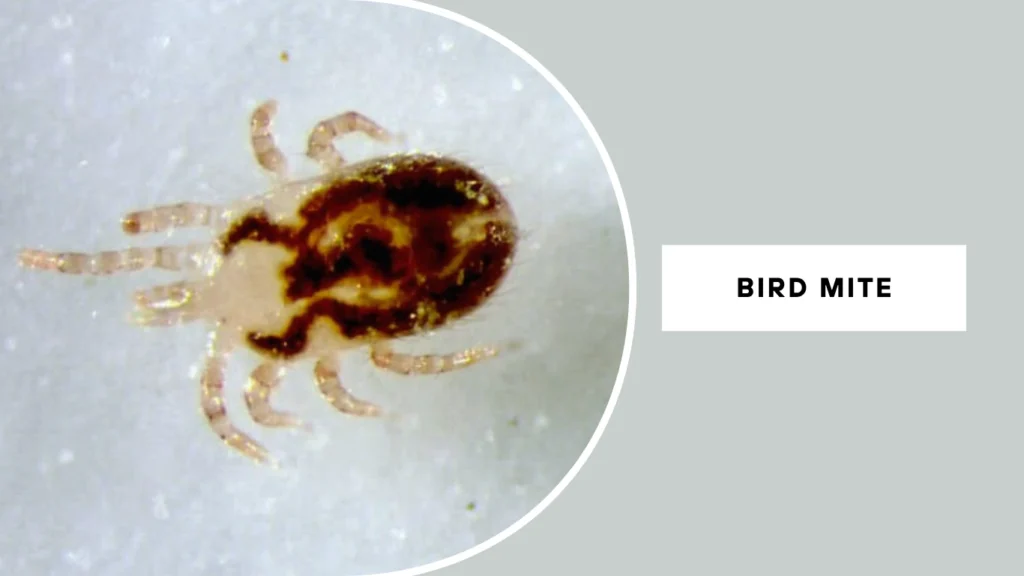
Bird mites are parasitic mites that primarily infest birds like pigeons, sparrows, and chickens. However, when birds leave their nests or die, these mites may invade nearby homes searching for a new host. Though they can bite humans, they cannot reproduce without a bird host.
Identification
- Size: 0.5 mm
- Color: Transparent or reddish after feeding
- Shape: Oval, with eight legs
- Movement: Fast-moving, visible under magnification
- Host-dependent: Cannot complete life cycle on humans
Infestation Source
Bird nests near vents, roofs, chimneys, or air conditioners are common sources. Mites may enter homes when birds abandon or die in these nests.
Bite Symptoms
Though they don’t live on humans, their bites can cause intense itching, red bumps, and skin irritation, often mistaken for bed bug bites.
Elimination Strategies
Locate and remove bird nests, clean the affected area thoroughly, use insecticidal sprays, and consult pest control if the infestation persists.
5. Rodent Mite (Laelaps echidninus)

Rodent mites are typically found on rats and mice but may bite humans when their rodent hosts die or migrate. They are known to infest homes with rodent problems and can survive without a host for several days.
Identification
- Size: Around 0.4–0.5 mm
- Color: Grayish-white or pale
- Shape: Round body, eight legs
- Host: Common on rats and mice
- Behavior: Actively move toward heat sources
Transmission to Homes
They spread from rodent nests in attics, walls, or basements and may enter human living spaces when rodents are removed or die off.
Effects on Humans
Rodent mite bites can cause dermatitis, red rashes, and itching. Bites often occur at night, typically on exposed skin areas.
Control and Management
Eliminate rodents, clean nesting areas, use targeted miticides, and seal entry points to prevent re-infestation. A professional pest inspection is often necessary.
6. Mold Mite (Tyrophagus putrescentiae)
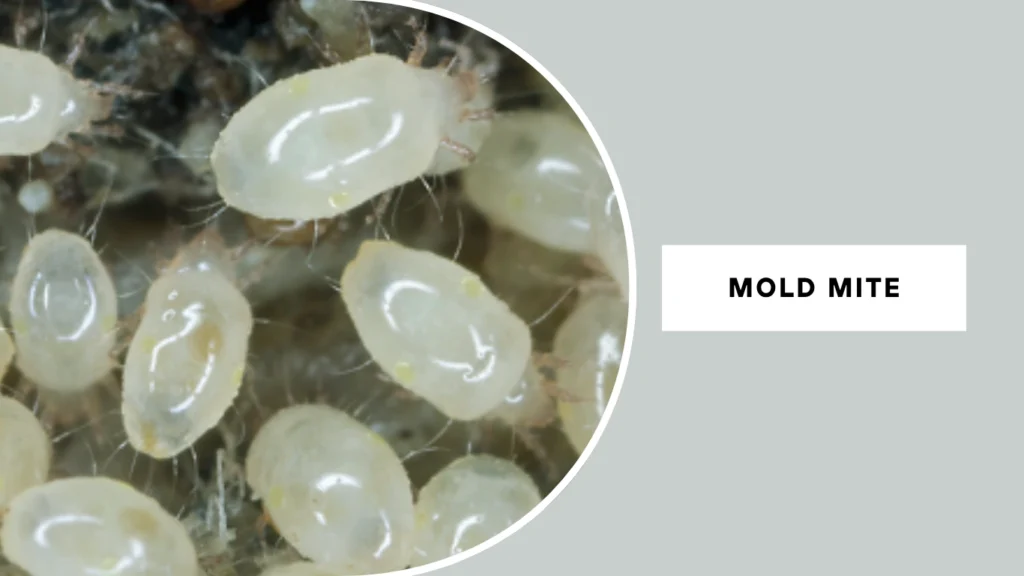
Mold mites are small, translucent mites that thrive in damp, moldy environments. They are commonly found in kitchens, bathrooms, and around leaky pipes or appliances. While they don’t bite, their presence often indicates underlying moisture or mold issues in the home.
Identification
- Size: 0.2–0.5 mm
- Color: White to translucent
- Body: Oval-shaped, with fine hairs
- Visibility: Seen under strong magnification
- Behavior: Found near moldy food or surfaces
Environmental Preference
They require high humidity (above 65%) and a moldy food source, making poorly ventilated and moisture-prone areas ideal for infestations.
Signs of Infestation
You may notice a dusty white coating on surfaces, a musty odor, or clumps of mites around moldy food, stored grains, or cupboards.
How to Manage
Improve ventilation, use dehumidifiers, clean mold thoroughly, discard infested food, and fix water leaks to eliminate the conditions mold mites need to thrive.
7. Grain Mite (Acarus siro)
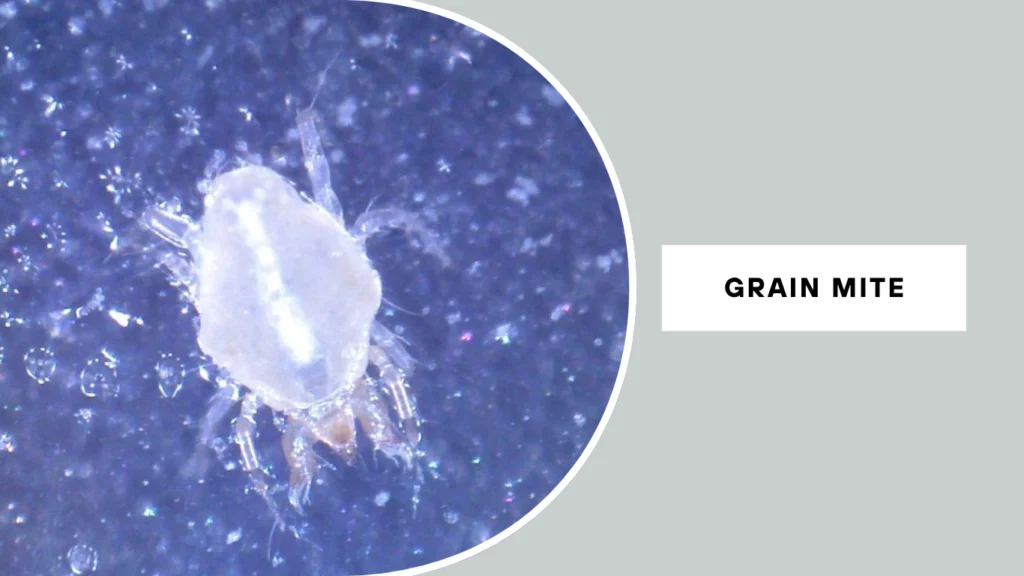
Grain mites commonly infest stored food products like flour, grains, cereals, and cheese. They thrive in humid environments and can cause contamination and spoilage. These mites are a common problem in pantries and food storage areas.
Identification
- Size: About 0.3 mm
- Color: Whitish with a shiny surface
- Shape: Round with long, hair-like setae
- Movement: Slow and often appear in clusters
- Often found: In food storage containers
Infestation Sites
Flour bins, grain sacks, pet food bags, and pantry shelves with poor sealing or high humidity are frequent infestation locations.
Health Concerns
Though not harmful through bites, inhaling grain mite particles can lead to allergic reactions and skin conditions like “grocer’s itch.”
Prevention and Cleanup
Store dry foods in airtight containers, keep humidity low, clean storage regularly, and dispose of any infested food promptly.
8. Itch Mite (Pyemotes herfsi)
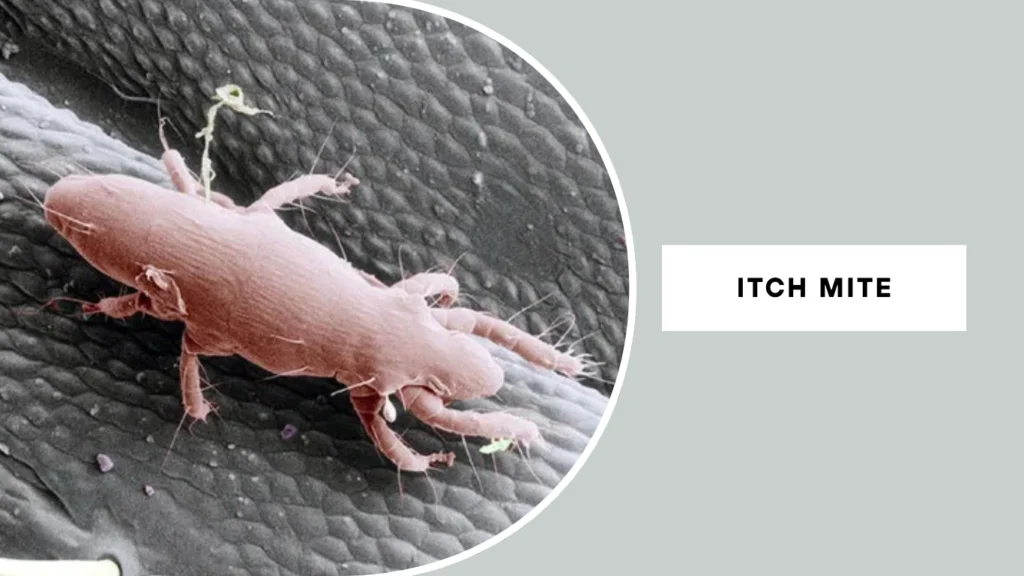
Itch mites are microscopic parasites that usually feed on insect larvae, especially in grain or hay. However, they can bite humans when disturbed from their environment, causing skin irritation. These mites don’t live on humans but may be encountered indoors near infested materials.
Identification
- Size: Less than 0.2 mm
- Color: Virtually transparent
- Host: Parasitizes insect larvae
- Visibility: Requires a microscope to detect
- Behavior: Bites occur unexpectedly and are hard to trace
Source of Infestation
They are commonly found in hay, straw, or stored grain that is infested with insects. Handling these materials can result in bites.
Human Reaction
Bites cause intense itching, small red welts, and sometimes blisters. Reactions often appear hours after exposure and may persist for several days.
Management Tips
Avoid handling infested hay or straw indoors, wear gloves when dealing with such materials, and ventilate storage areas to discourage mites.
9. Cheese Mite (Tyrophagus casei)
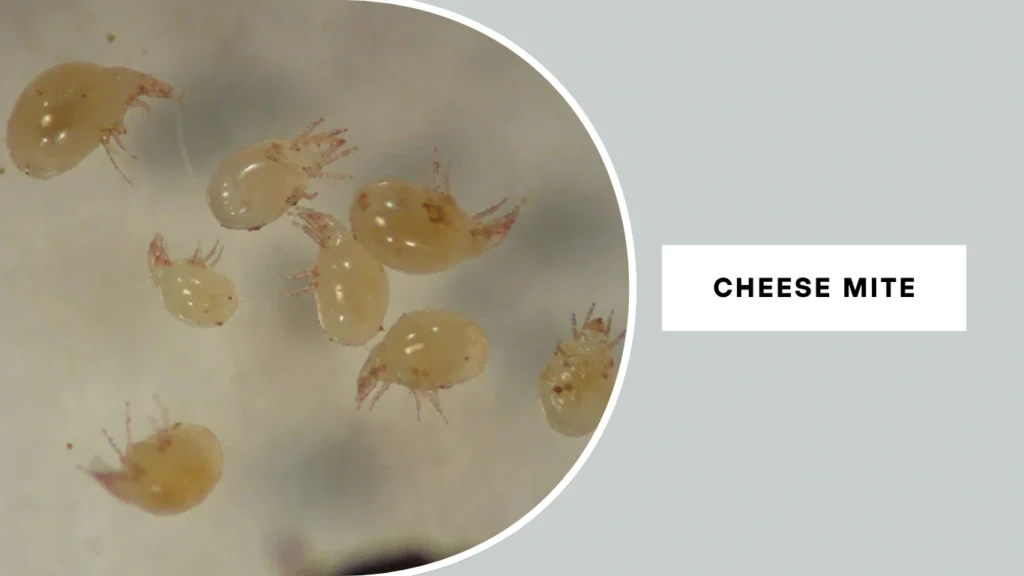
Cheese mites are found on the surfaces of aging cheeses, where they contribute to flavor development in certain traditional cheese types. However, in homes, they may infest improperly stored cheese or food items, becoming a hygiene concern.
Identification
- Size: 0.4 mm
- Color: Cream to white
- Body: Soft-bodied with bristly hairs
- Habitat: Found on cheese and fatty foods
- Odor: Infestations may produce a strong smell
Common Locations
These mites appear on aged or moldy cheese, cured meats, or oily pantry items if they are not sealed or stored correctly.
Effects on Humans
Though generally not dangerous, ingestion or handling can cause allergic reactions, and in large numbers, they may spoil food products.
Control Measures
Store cheese in the refrigerator, inspect packaging, clean food storage areas frequently, and discard infested items to prevent re-infestation.
10. Demodex Mite (Demodex folliculorum)
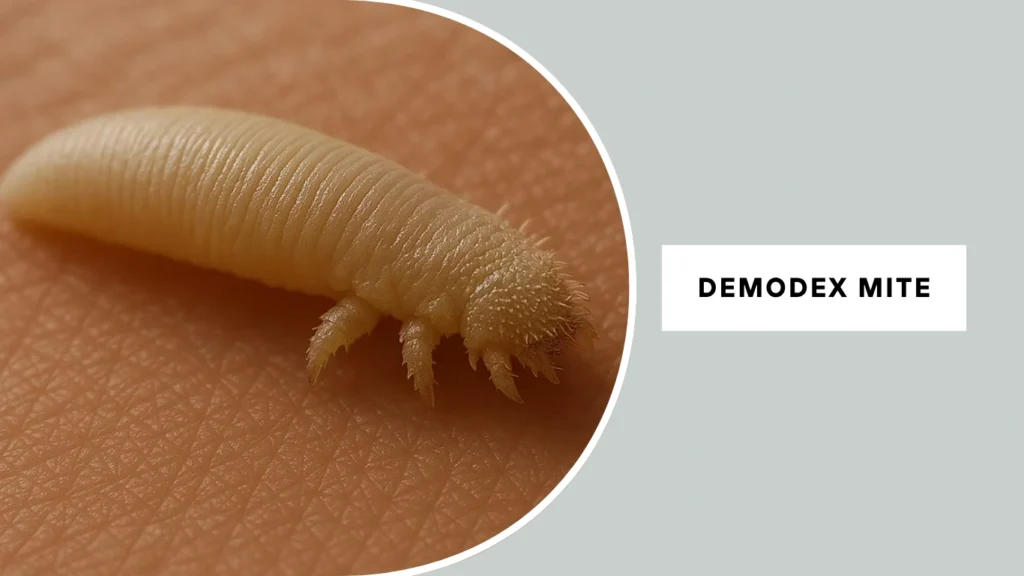
Demodex folliculorum is a type of mite that naturally lives in the hair follicles of human skin, especially on the face. These mites are usually harmless and go unnoticed, but overpopulation can lead to skin issues such as rosacea or inflammation.
Identification
- Size: 0.3–0.4 mm
- Shape: Elongated, worm-like body with eight legs near the head
- Color: Transparent or pale
- Location: Found in hair follicles and sebaceous glands
- Behavior: Active at night
Where It Lives
Commonly found on the forehead, cheeks, nose, and eyelashes. They thrive in oily skin and reproduce in the pores and follicles.
Symptoms of Overgrowth
Increased numbers may lead to clogged pores, irritation, itching, redness, and even conditions like blepharitis (eyelid inflammation).
Treatment Options
Mild cases may not require treatment. For severe infestations, topical creams (like tea tree oil or metronidazole) and improved facial hygiene are often effective.
11. Demodex Mite (Demodex brevis)
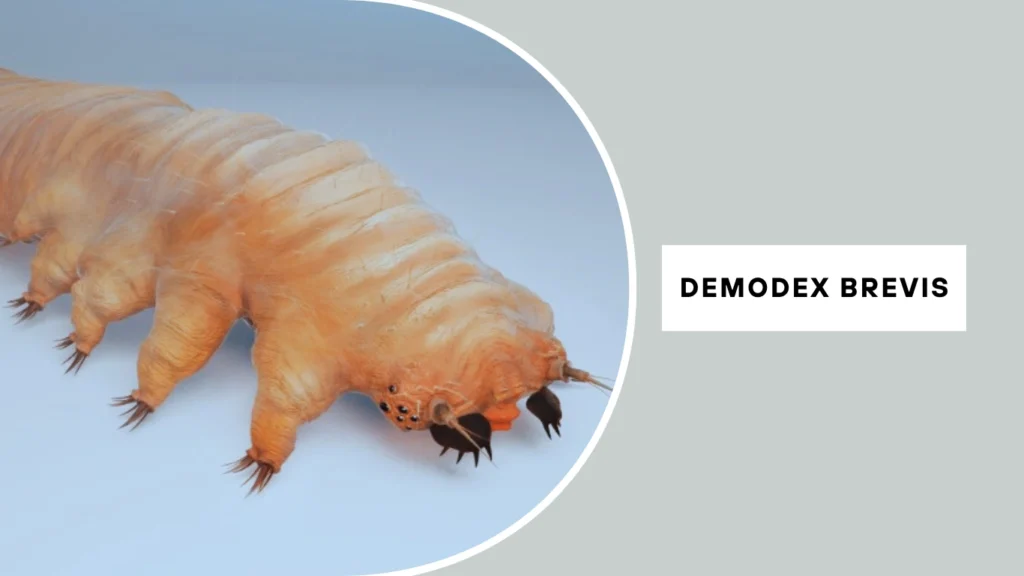
Demodex brevis is another species of human skin mite, similar to Demodex folliculorum, but it lives deeper in sebaceous glands rather than hair follicles. It is part of the normal skin flora but may contribute to dermatological issues if it multiplies excessively.
Identification
- Size: Slightly smaller than D. folliculorum
- Shape: Stumpy, short-bodied with eight legs
- Habitat: Sebaceous (oil) glands rather than follicles
- Visibility: Microscopic and not visible to the eye
- Movement: Comes out at night to feed and mate
Common Locations
Found mainly on the face, especially the nose, forehead, chin, and around the eyes. Prefers oily areas with large sebaceous glands.
Skin Conditions Linked
Overgrowth may lead to acne-like eruptions, rosacea, or inflammation, especially in people with weakened immune systems or oily skin.
Management Techniques
Topical anti-parasitic treatments and proper facial cleansing can reduce the mite population. Medical diagnosis is recommended if symptoms persist.
12. Tropical Rat Mite (Ornithonyssus bacoti)
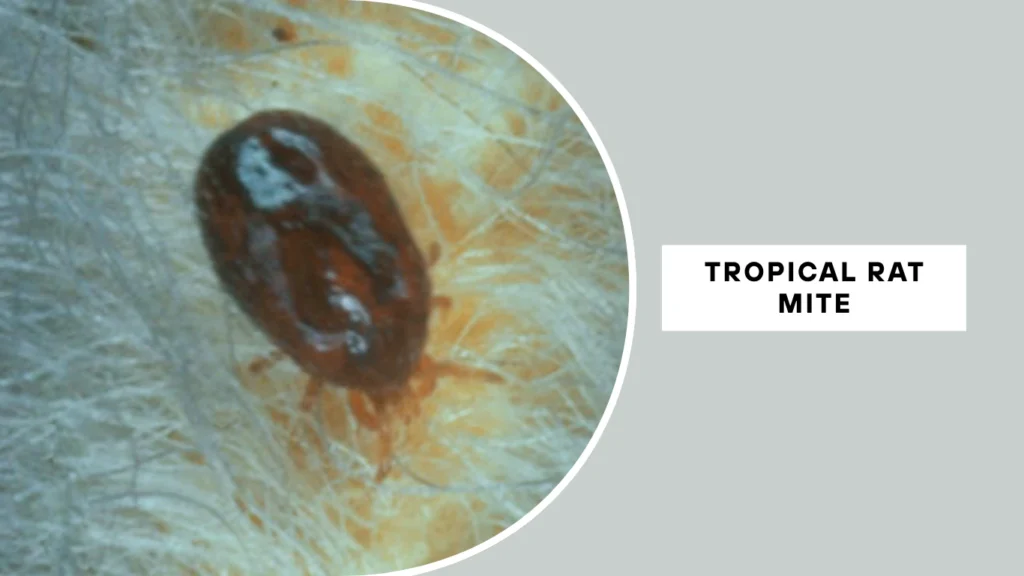
The tropical rat mite is a blood-feeding ectoparasite primarily associated with rats, especially in urban environments. When rodent hosts die or migrate, these mites may invade nearby buildings and bite humans. Though they do not live on humans, their bites can cause significant irritation.
Identification
- Size: Around 1 mm
- Color: Grayish-white, turns reddish after feeding
- Shape: Oval body, long legs
- Behavior: Actively moves in search of a host
- Visibility: Barely visible without magnification
Infestation Path
Usually enters homes through walls, attics, or basements connected to rodent nests. Infestations often spike after rodent extermination.
Human Impact
Bites result in itchy, red welts and sometimes allergic reactions. Mites are most active at night and can cause anxiety due to persistent biting.
Removal Tips
Rodent control is the first step. Afterward, clean all nesting materials, vacuum thoroughly, and use insecticidal sprays approved for mite treatment indoors.
13. Poultry Red Mite (Dermanyssus gallinae)

Also known as the chicken mite, this parasitic mite primarily infests birds like chickens but may bite humans in close contact with poultry or infested coops. It feeds at night and hides in cracks and crevices during the day.
Identification
- Size: 0.6–1 mm
- Color: Gray when unfed; turns red after feeding
- Shape: Oval body with long legs
- Visibility: Barely visible to the naked eye
- Activity: Nocturnal feeder
Entry to Homes
These mites may enter homes from backyard poultry setups, abandoned coops, or when infested birds are brought indoors or nearby.
Effects on People
Bites cause itching, red bumps, and skin irritation, especially on exposed areas. Heavy infestations can be distressing.
Treatment and Prevention
Clean and treat chicken coops regularly, wear protective clothing when handling birds, and seal cracks around the home to prevent entry.
14. Flour Mite (Acarus siro)
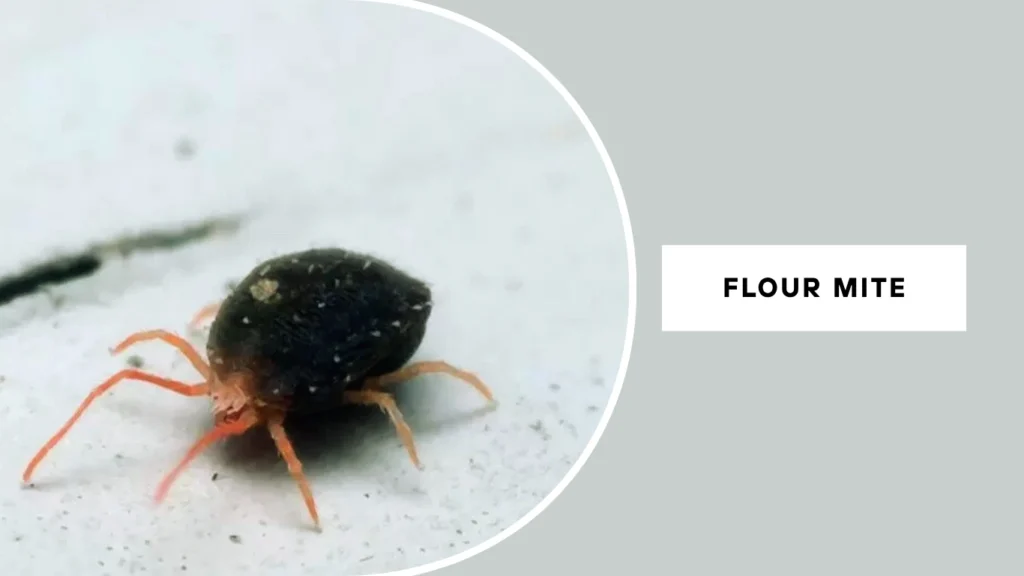
Flour mites are common pantry pests that infest flour, grains, cereals, and other dry stored food. While they do not bite or harm humans directly, their presence can cause food spoilage and allergic reactions in some people.
Identification
- Size: About 0.3–0.5 mm
- Color: Whitish or cream with brownish legs
- Shape: Round body covered in fine hairs
- Movement: Slow-moving, usually found in large numbers
- Habitat: Stored dry foods and packaging
Infestation Sources
Flour mites infest packaging, bins, and containers that are poorly sealed or stored in humid conditions. They may also appear in pet food and bird seed.
Effects on Health
Inhaling mite-contaminated dust may lead to sneezing, coughing, or skin rashes in sensitive individuals. Long-term exposure can cause “baker’s itch” or asthma.
Prevention and Cleanup
Keep storage areas dry, store food in airtight containers, rotate stock regularly, and dispose of contaminated items. Clean shelves thoroughly with vinegar or hot water.
15. Straw Itch Mite (Pyemotes tritici)
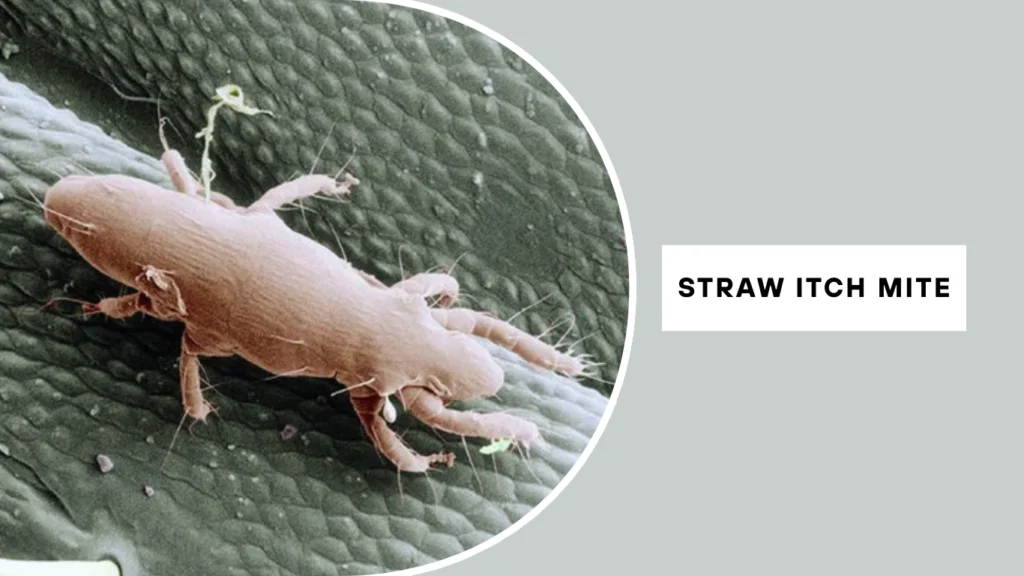
Straw itch mites are parasites of insect larvae found in straw, hay, grain, and wood shavings. Humans become accidental hosts when handling infested materials. Though microscopic, their bites can cause severe skin reactions.
Identification
- Size: Less than 0.2 mm
- Color: Transparent to pale beige
- Shape: Slender body with long legs
- Host: Parasitizes insect larvae in straw and grain
- Visibility: Not visible to the naked eye
Common Exposure
Occurs during handling of straw bales, grain sacks, or old furniture stuffed with organic material. Infestations are more common in rural or agricultural settings.
Symptoms After Bites
Bites cause red, itchy welts or rashes—often grouped in clusters. Skin irritation can last several days and may require topical treatment.
Protective Measures
Avoid direct contact with infested materials, wear gloves and long sleeves, and store hay and grain in dry, ventilated spaces. Treat affected areas with antihistamines or corticosteroid creams.

